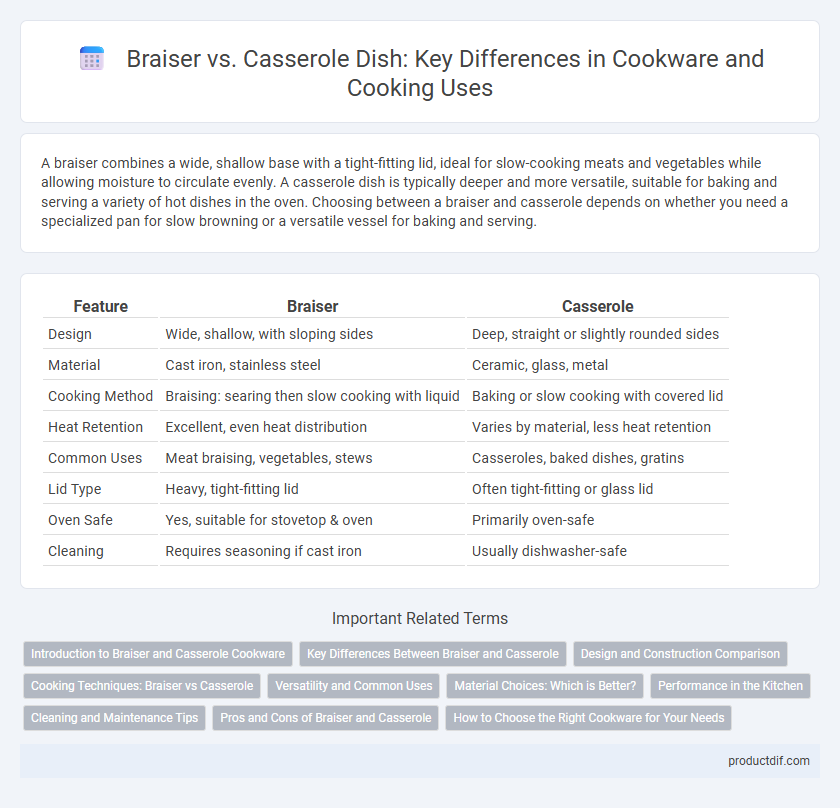A braiser combines a wide, shallow base with a tight-fitting lid, ideal for slow-cooking meats and vegetables while allowing moisture to circulate evenly. A casserole dish is typically deeper and more versatile, suitable for baking and serving a variety of hot dishes in the oven. Choosing between a braiser and casserole depends on whether you need a specialized pan for slow browning or a versatile vessel for baking and serving.
Table of Comparison
| Feature | Braiser | Casserole |
|---|---|---|
| Design | Wide, shallow, with sloping sides | Deep, straight or slightly rounded sides |
| Material | Cast iron, stainless steel | Ceramic, glass, metal |
| Cooking Method | Braising: searing then slow cooking with liquid | Baking or slow cooking with covered lid |
| Heat Retention | Excellent, even heat distribution | Varies by material, less heat retention |
| Common Uses | Meat braising, vegetables, stews | Casseroles, baked dishes, gratins |
| Lid Type | Heavy, tight-fitting lid | Often tight-fitting or glass lid |
| Oven Safe | Yes, suitable for stovetop & oven | Primarily oven-safe |
| Cleaning | Requires seasoning if cast iron | Usually dishwasher-safe |
Introduction to Braiser and Casserole Cookware
Braiser cookware features a wide, shallow base with tall, sloping sides designed for searing and slow-cooking meats in liquid, ideal for creating tender, flavorful dishes. Casserole cookware typically has deeper, straight sides and a tight-fitting lid, making it perfect for oven-baked or stovetop recipes that require even heat distribution and moisture retention. Both cookware types are commonly made from materials like enameled cast iron or stainless steel to ensure durability and optimal heat conduction.
Key Differences Between Braiser and Casserole
A braiser features a wide, shallow base with a tight-fitting lid designed for slow cooking and browning large cuts of meat, while a casserole typically has higher sides and is intended for baking and serving stews or mixed dishes. Braisers excel in techniques like searing followed by gentle simmering, promoting even heat distribution and moisture retention essential for tenderizing. Casseroles, often made from ceramic or enameled materials, prioritize oven-baking versatility and aesthetic presentation.
Design and Construction Comparison
Braisers feature a wide, shallow design with a tight-fitting lid and sloped sides to facilitate browning and slow cooking, while casseroles often have higher, straighter sides suited for baking and stewing. Braisers are typically made from heavy-duty materials like cast iron enameled for excellent heat retention and even distribution. Casseroles may be crafted from ceramic, glass, or metal, prioritizing versatility and even cooking but with less emphasis on searing capabilities.
Cooking Techniques: Braiser vs Casserole
Braising involves cooking food slowly in a small amount of liquid at low heat, typically in a heavy, lidded pot designed to retain moisture and distribute heat evenly. Casserole cooking uses an oven-safe dish to bake a mixture of ingredients together, often with more liquid or sauce, allowing for even roasting and slow simmering. Both techniques enhance flavor through slow cooking but differ in heat source and moisture control, with braising primarily stovetop and casserole focused on baking.
Versatility and Common Uses
A braiser is designed with a wide, shallow shape ideal for browning meats and slow-cooking with moisture, making it perfect for recipes like pot roasts and braised vegetables. A casserole dish usually has taller sides and is primarily used for oven baking layered dishes, gratins, and casseroles that require even heat distribution. Both cookware types offer versatility, but braisers excel in stovetop-to-oven cooking methods, while casseroles specialize in baking and serving one-dish meals.
Material Choices: Which is Better?
Braisers are typically made from heavy-duty materials like cast iron or enameled cast iron, providing excellent heat retention and even cooking, ideal for slow braising. Casseroles often feature ceramic or stoneware construction, offering superior heat distribution and a non-reactive surface that enhances flavor without affecting food acidity. Choosing between these materials depends on cooking style: cast iron excels for intense searing and braising, while ceramic casseroles are better suited for gentle, oven-based baking and serving.
Performance in the Kitchen
A braiser excels at slow-cooking and searing, offering superior heat retention and even distribution to tenderize tough cuts of meat. A casserole dish is designed for oven baking and roasting, providing consistent heat suitable for layered ingredients and longer cooking times. Both cookware types enhance flavor development but differ in performance with the braiser favoring stovetop use and the casserole optimized for oven applications.
Cleaning and Maintenance Tips
Braisers and casseroles often feature enamel or stainless steel surfaces that require gentle cleaning with non-abrasive sponges to prevent scratching. Hand washing with warm, soapy water and drying immediately helps maintain the finish and prevents rust, especially for cast iron braisers. Regular seasoning of cast iron braisers enhances durability, while casseroles with non-stick coatings benefit from avoiding metal utensils to extend their lifespan.
Pros and Cons of Braiser and Casserole
A braiser excels in searing meat with its wide, shallow shape, promoting even browning and moisture retention, ideal for slow-cooked dishes but may lack versatility for stovetop-to-oven use. A casserole offers deep, uniform heat distribution and excellent oven performance, perfect for layered, baked meals but tends to be heavier and less efficient for quick searing or browning. Choosing between them hinges on cooking technique preferences and recipe requirements, balancing braiser's superior searing capacity against casserole's baking strengths.
How to Choose the Right Cookware for Your Needs
Selecting the right cookware depends on your cooking style and dish preferences, with braisers ideal for slow-cooking and searing meats due to their wide, shallow shape and tight-fitting lids. Casserole dishes excel at evenly baking and simmering stews or casseroles, featuring a deeper, more rounded design for liquid retention. Consider the type of meals you frequently prepare and prioritize materials like cast iron for heat retention or enameled surfaces for easy cleaning when choosing between a braiser and casserole.
Braiser vs Casserole Infographic

 productdif.com
productdif.com